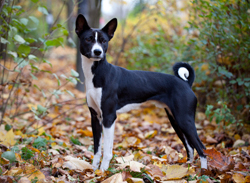Basenjis are small, short haired hunting dogs originally from Africa. These dogs are lightly built with a wrinkled head and a high, curled tail that bends over the back. Their eye color ranges from dark hazel to dark brown and their eyes are almond shaped. Coat colors include brindle, chestnut, and pure black, and the breed has a white chest and tail tip and all white feet. The ears are small and erect. Basenji dogs measure 16 to 17 inches tall at the shoulder and weigh 22 to 24 pounds. With proper care, they live up to 12 years.
They make good companion animals due to their intelligence, affectionate nature, and independence.
These dogs are agile, poised, elegant, and graceful. They make good companion animals due to their intelligence, affectionate nature, and independence. Although these dogs are alert and playful, their forehead wrinkles give the impression that they are constantly worried.
Basenjis are commonly known as the "barkless dog" because they do not bark like other dogs. Instead, these dogs make a yodel sound when excited. They actually have a whole range of crows, screams, growls, and yodels and they're not afraid to use them.
Basenjis are a playful and active breed known for their independent natures and fastidious habits. Although these dogs can be aloof at times and are generally wary of strangers, they warm quickly and can be very devoted to their human companions.
These lively, curious, and often funny dogs are cat-like in their attitude and cleanliness. They get along decently with older children, but this breed is not well suited to households with young children, cats, other dogs, or a lot of commotion.
Basenjis must have patient and understanding human companions with a good sense of humor; these dogs have a knack for finding and causing trouble and have been known to bury, chew, or otherwise destroy valuables. They appreciate physical activity and enjoy spending time outdoors, but this breed should live indoors with companionship. These dogs may become depressed if ignored or neglected.
Although Basenji dogs are generally healthy, the breed is prone to several potentially serious health conditions that require veterinary treatment. These dogs are at risk for developing a type of inflammatory bowel disease called immunoproliferative small intestine disease, or IPSID. This disease prevents dogs from absorbing and using nutrients obtained from food.
Basenjis are also at risk for Fanconi syndrome, a kidney disorder, and certain eye diseases, including persistent pupillary membrane, coloboma, and progressive retinal atrophy. These dogs are also more prone than other breeds to developing umbilical hernias and pyruvate kinase deficiency, a disorder that can lead to hemolytic anemia. Autoimmune thyroiditis is also known to affect Basenjis.
Routine veterinary care, which includes preventative testing and standard vaccinations, along with proper nutrition and regular exercise help ensure Basenjis live a full life of 10 to 12 years.
The Basenji breed is highly intelligent and is not easily trainable. These dogs have limited social needs, but they should be socialized at an early age to make them more tolerant of other animals. They are somewhat territorial and sometimes make good watchdogs, although this depends considerably on the individual dog. Even Basenjis that protect their homes one day may allow a burglar free access the next.
The breed can be destructive and mischievous and is known for destroying possessions. Keep these dogs active to wear them out and prevent misbehavior. Obedience, tracking, lure coursing, and agility are good activities for these dogs. Of course, Basenjis need mental stimulation, too, and should be provided with plenty of attention and puzzle toys. Confining these dogs to a fenced yard when they are outside will keep them from chasing small animals. Underground fences will not contain this breed. Noise may be an issue for Basenjis living an urban environment. Barkless does not mean being silent, and these dogs can make a lot of noise when they want to.
Training with patience, consistency, and firmness will help prevent negative behavior patterns from developing. Training sessions should be kept short and positive reinforcement should be utilized to ensure as much success as possible.
A low-maintenance breed with a fine, short coat, Basenjis need weekly brushings to remove dead hair. A quick grooming session with a soft bristle brush, rubber curry brush, or hound mitt is usually enough to keep shedding under control and distribute skin oils for coat shine and health.
Basenjis rarely need bathing and should be washed with a mild, canine shampoo only when necessary to remove oil, stickiness, or harmful substances from the coat. These dogs are self-grooming, much like cats, and the breed lacks the normal odor associated with most dogs. The ears must be checked regularly for signs of infection, such as redness, discharge, and odor. Keeping the ears clean and dry goes a long way toward preventing infections.
The nails should be trimmed a few times each month, or more often if needed, and the teeth require frequent brushing to prevent dental decay and gum disease. Regular brushing, dental treats, and the occasional professional dental cleaning will keep the breath smelling fresh and the mouth healthy.
Basenjis are native to Central Africa and Europeans first found the dogs in the Congo and in Zaire and Sudan. The breed was prized in Africa for its hunting prowess, and these dogs were given to the pharaohs of Ancient Egypt as gifts. Images of the breed are found inside tombs of the pharaohs of Egypt.
The dogs were introduced to England in 1937, and English breeders spent time refining the breed and exporting it around the world. In 1941, the first litter was raised to maturity in the United States.
In Africa, these dogs are primarily used for pointing, retrieving, and driving game. They are used as hunting dogs in the United States as well, but they are also very popular companion animals.
The American Kennel Club officially recognized the Basenji in 1944.

